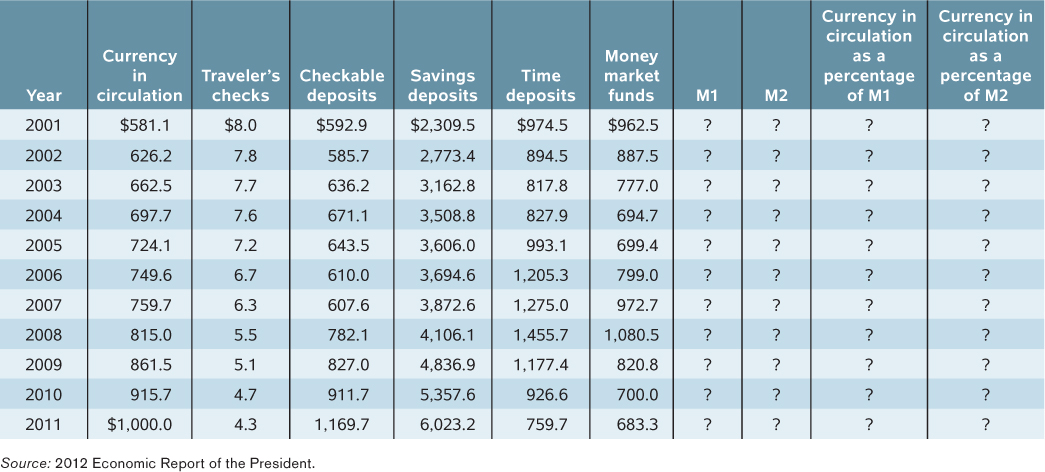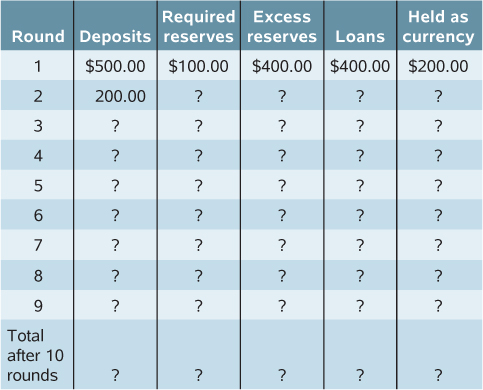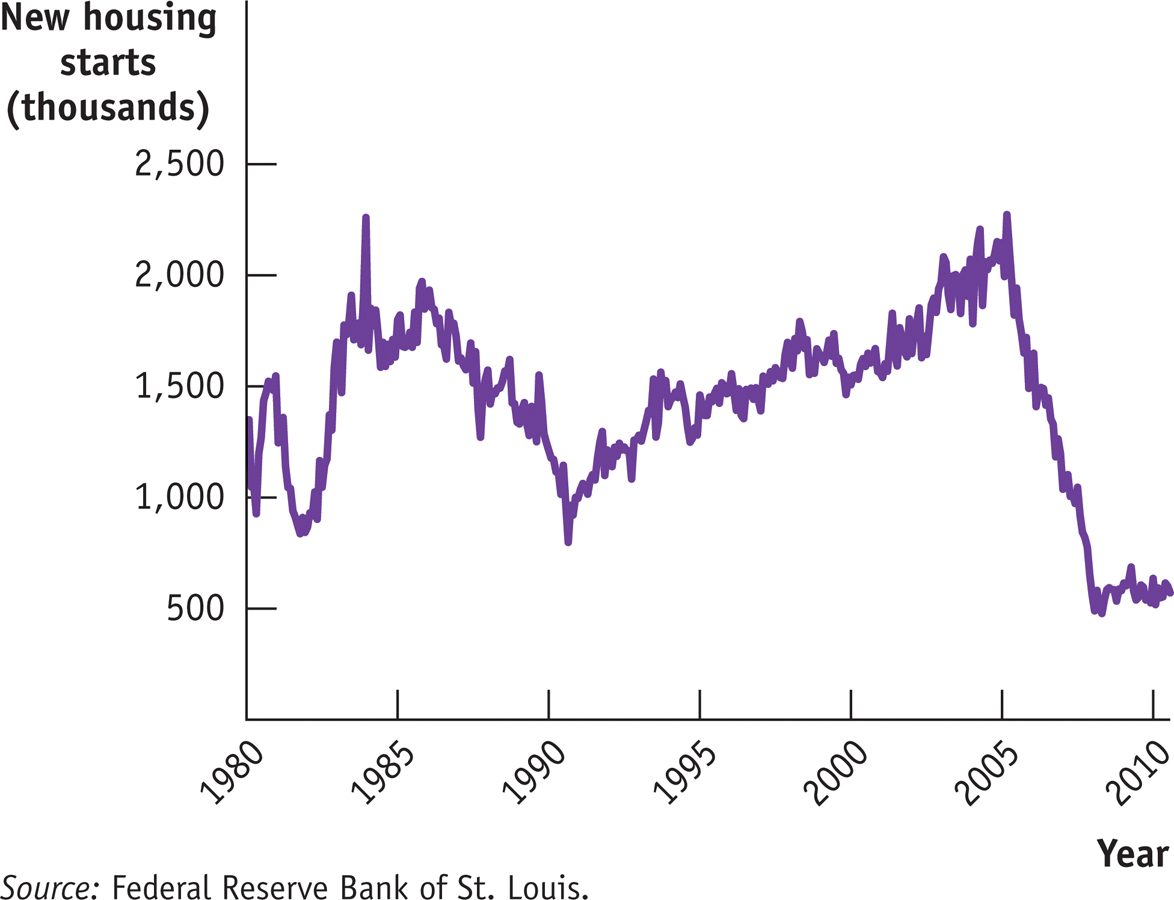Problems
1.For each of the following transactions, what is the initial effect (increase or decrease) on M1? On M2?
You sell a few shares of stock and put the proceeds into your savings account.
You sell a few shares of stock and put the proceeds into your checking account.
You transfer money from your savings account to your checking account.
You discover $0.25 under the floor mat in your car and deposit it in your checking account.
You discover $0.25 under the floor mat in your car and deposit it in your savings account.
2.There are three types of money: commodity money, commodity-
Bottles of rum were used to pay for goods in colonial Australia.
Salt was used in many European countries as a medium of exchange.
For a brief time, Germany used paper money (the “Rye Mark”) that could be redeemed for a certain amount of rye, a type of grain.
The town of Ithaca, New York, prints its own currency, the Ithaca HOURS, which can be used to purchase local goods and services.
3.The following table shows the components of M1 and M2 in billions of dollars for the month of December in the years 2001 to 2011 as published in the 2012 Economic Report of the President. Complete the table by calculating M1, M2, currency in circulation as a percentage of M1, and currency in circulation as a percentage of M2. What trends or patterns about M1, M2, currency in circulation as a percentage of M1, and currency in circulation as a percentage of M2 do you see? What might account for these trends?

4.Indicate whether each of the following is part of M1, M2, or neither:
$95 on your campus meal card
$0.55 in the change cup of your car
$1,663 in your savings account
$459 in your checking account
100 shares of stock worth $4,000
A $1,000 line of credit on your Sears credit card
5.Tracy Williams deposits $500 that was in her sock drawer into a checking account at the local bank.
How does the deposit initially change the T-
account of the local bank? How does it change the money supply? If the bank maintains a reserve ratio of 10%, how will it respond to the new deposit?
If every time the bank makes a loan, the loan results in a new checkable bank deposit in a different bank equal to the amount of the loan, by how much could the total money supply in the economy expand in response to Tracy’s initial cash deposit of $500?
If every time the bank makes a loan, the loan results in a new checkable bank deposit in a different bank equal to the amount of the loan and the bank maintains a reserve ratio of 5%, by how much could the money supply expand in response to Tracy’s initial cash deposit of $500?
6.Ryan Cozzens withdraws $400 from his checking account at the local bank and keeps it in his wallet.
How will the withdrawal change the T-
account of the local bank and the money supply? If the bank maintains a reserve ratio of 10%, how will it respond to the withdrawal? Assume that the bank responds to insufficient reserves by reducing the amount of deposits it holds until its level of reserves satisfies its required reserve ratio. The bank reduces its deposits by calling in some of its loans, forcing borrowers to pay back these loans by taking cash from their checking deposits (at the same bank) to make repayment.
If every time the bank decreases its loans, checkable bank deposits fall by the amount of the loan, by how much will the money supply in the economy contract in response to Ryan’s withdrawal of $400?
If every time the bank decreases its loans, checkable bank deposits fall by the amount of the loan and the bank maintains a reserve ratio of 20%, by how much will the money supply contract in response to a withdrawal of $400?
7.The government of Eastlandia uses measures of monetary aggregates similar to those used by the United States, and the central bank of Eastlandia imposes a required reserve ratio of 10%. Given the following information, answer the questions below.
Bank deposits at the central bank = $200 million
Currency held by public = $150 million
Currency in bank vaults = $100 million
Checkable bank deposits = $500 million
Traveler’s checks = $10 million
What is M1?
What is the monetary base?
Are the commercial banks holding excess reserves?
Can the commercial banks increase checkable bank deposits? If yes, by how much can checkable bank deposits increase?
8.In Westlandia, the public holds 50% of M1 in the form of currency, and the required reserve ratio is 20%. Estimate how much the money supply will increase in response to a new cash deposit of $500 by completing the accompanying table. (Hint: The first row shows that the bank must hold $100 in minimum reserves—

9.What will happen to the money supply under the following circumstances in a checkable-
The required reserve ratio is 25%, and a depositor withdraws $700 from his checkable bank deposit.
The required reserve ratio is 5%, and a depositor withdraws $700 from his checkable bank deposit.
The required reserve ratio is 20%, and a customer deposits $750 to her checkable bank deposit.
The required reserve ratio is 10%, and a customer deposits $600 to her checkable bank deposit.
10.Although the U.S. Federal Reserve doesn’t use changes in reserve requirements to manage the money supply, the central bank of Albernia does. The commercial banks of Albernia have $100 million in reserves and $1,000 million in checkable deposits; the initial required reserve ratio is 10%. The commercial banks follow a policy of holding no excess reserves. The public holds no currency, only checkable deposits in the banking system.
How will the money supply change if the required reserve ratio falls to 5%?
How will the money supply change if the required reserve ratio rises to 25%?
11.Using Figure 71-1, find the Federal Reserve district in which you live. Go to http:/
12.The Congressional Research Service estimates that at least $45 million of counterfeit U.S. $100 notes produced by the North Korean government are in circulation.
Why do U.S. taxpayers lose because of North Korea’s counterfeiting?
As of March 2013, the interest rate earned on one-
year U.S. Treasury bills was 0.14%. At a 0.14% rate of interest, what is the amount of money U.S. taxpayers are losing per year because of these $45 million in counterfeit notes?
13.The accompanying figure shows new U.S. housing starts, in thousands of units per month, between January 1980 and August 2011. The graph shows a large drop in new housing starts in 1984–
What caused the drop in new housing starts in 1984–
1991? What caused the drop in new housing starts in 2006–
2009? How could better regulation of financial institutions have prevented these two instances?

